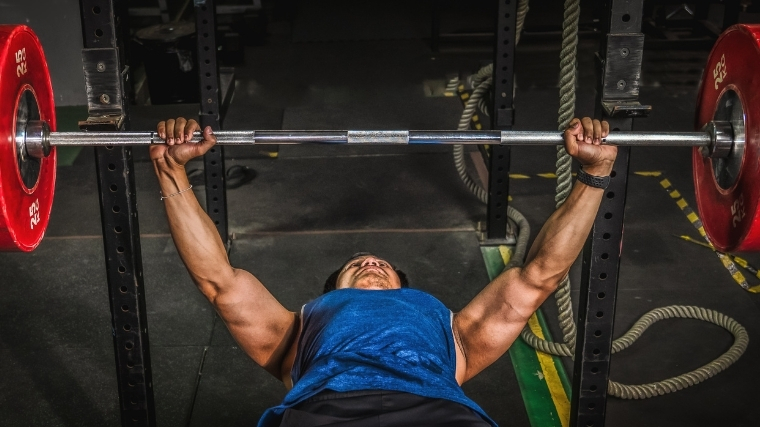The past two decades have seen a wonderful and much-needed rise in evidence-based training, much of which is available online. This means that many gym-goers now worry about volume, intensity, reps to failure, and a host of other factors that have been nonissues for decades. Such terms, and the new workout plans built around them, largely call into question the validity of the previously hallowed body part or ‘bro split.’
When first starting in the gym, any new lifter usually follows some bro split variation. It goes like this: Chest on Monday, back on Tuesday, legs on Wednesday, shoulders/calves on Thursday, and arms on Friday before resting that weekend and beginning all over again. For many bodybuilders, it is still a time and tested method of training.
Bro splits have not always been the norm fitness community, however. In fact, they only rose to prominence in the mid-twentieth century and grew rapidly in popularity from the 1960s. All of this begs the question, when were bro splits invented? And why did they become so commonplace in the fitness industry?
The Origin of Bro Splits
To answer that question, we need to ask another one first. How did lifters train before bro splits? The answer is full-body workouts. When Eugen Sandow and the first great wave of physical culturists helped ignite interest in gym cultures in the early 1900s, they did so largely on the back of full-body workouts. That is, as the name implies, when you train your entire body each session.

[Related: What Are Workouts Splits and Which is the Best One?]
This carried through the following decades. In fact, lifters from the late nineteenth century to the 1940s, 1950s, and even 1960s largely used full-body workouts. Some lifters, like Reg Park, the man who inspired Arnold Schwarzenegger to start training, used 5×5 strength programs to build their physiques. (1)
Others like Steve Reeves, a contemporary of Park and the possessor of one of the finest physiques in bodybuilding, incorporated sculpting exercises into their routines. (2) This, incidentally, was also reminiscent of how Olympic weightlifters and strength athletes trained. When people wanted to gain weight fast, they used 20 rep squats three times a week in conjunction with bench presses and shoulder presses. It’s simply what lifters back then did.
This is not to say there weren’t outliers, but they were few in number. In 1940, American Olympic weightlifter Louis Abele published his radical training program, which included specialization blocks for certain body parts. (3) It wasn’t the bro split, but it was something. However, far more common were programs that followed guidelines similar to Bob Hoffman’s 1940s York Barbell workout. (4) At times, Hoffman would produce specialization workouts (i.e., leg day workouts), but his most publicized workouts were always full-body. Here’s an example of what a Hoffman full-body workout split looks like. (5)
- Barbell Curl: one set of six reps
- Overhead Press: one set of six reps
- Back Squat: one set of eight to 12 reps
- Dumbbell Pullover: one set of six reps
- Deadlift: one set of eight to 12 reps
- Bench Press: one set of six reps
- Side Bend: one set of six reps
- Jefferson Deadlift: one set of eight to 12 reps
- Standing Calf Raise: one set of eight to 12 reps
- Barbell Shrug: one set of six reps
Two decades later, Hoffman, and his many competitors, began heavily promoting those body-part splits programs, which later became known as bro splits. So what changed? Competition, in a variety of fields.
When Hoffman was publishing his workouts in the 1940s, he was effectively unrivaled in the fitness industry. He ran York Barbell, one of the few mass producers of exercise equipment, sold Strength & Health magazine, which was widely read, and he was the coach of the American weightlifting team. (6) He was on top, but this dominance did not last.
The Rise of the Weiders
From the 1950s onwards, Bob Hoffman faced a new rival in the Canadian born Weider brothers. In the late 1940s, Joe and Ben Weider began challenging Hoffman’s supremacy in the fitness industry through their own brand of nutritional supplements, bodybuilding magazines, and bodybuilding competitions. (7)
Part of their approach was to market their own bodybuilding workouts, which, Joe Weider often claimed, helped make the physiques of champions. Distinguishing himself from Hoffman, Weider promoted split body-part routines with cool names and techniques like the “flushing” approach whereby trainees used multiple sets and exercises for the same muscle groups. Joe also promoted cheating in certain exercises and various other approaches that Hoffman was often silent on. (8)
From the early 1950s, Weider began promoting body part splits for his readers. While his beginner routines would still use full-body workouts, those for advanced readers trained their upper body twice a week (e.g., on Monday and Thursday) and lower body twice a week (e.g., on Tuesday and Friday) – resting on Wednesday, Saturday, and Sunday. (9)
[Related: Burn Fat and Boost Your Work Capacity With Body Conditioning]
Importantly, Joe did all of this with reference to well-known athletes. His persona as the ‘trainer of champions’ meant that his approaches were soon associated with people like Reg Park and, later, Arnold.
Competition between Hoffman and Weider helped create the ‘bro split’ because the split allowed Weider to distinguish himself from Hoffman. Importantly, Weider was also a master publicist who made sure people knew exactly what he was promoting. Competition between Weider and Hoffman thus mattered. An equally important competition was in the sport of bodybuilding itself.
One of the reasons that full-body routines were popular in the early 1900s was because the sport of bodybuilding didn’t yet exist. Sure there were once-off competitions like Eugen Sandow’s show in 1901 or Bernarr MacFadden’s contests in the United States some years later, but regular, annual competitions were not available.
Think, for a moment, about what the ‘bro-split’ represents. Forgive the philosophical musings, but the ‘bro-split’ represents the desire to specialize muscles to a greater degree than is often possible with full-body routines. If no bodybuilding competitions exist, focusing on your biceps peaks seems somewhat pointless.
This explains, in part, why full-body routines were used. They worked in a variety of contexts, from Olympic to muscle gain. It was only in the late 1930s and early 1940s that regular bodybuilding shows for men began to be held. The first major show, the Mr. America contest, was held in 1939 and included Olympic weightlifting and a personality test in its bodybuilding divisions. (10)
This had two effects. People began to sculpt their bodies more, and athletes began to resent the weightlifting and personality components. In the late 1940s and early 1950s, rival organizations to the Mr. America show were created, and they focused solely on the body. (11) With contests now dedicated to the body, bodybuilders began to focus more on isolating certain muscle groups, which encouraged body part splits. Riding this wave was Joe Weider and others, but they all benefited from changes in the nature of bodybuilding itself.
The Influence of Bodybuilding
Competition in bodybuilding and competition in the fitness industry generally led to a third, often neglected factor in the invention of bro splits — the rise of anabolic steroids. While some lifters may have experimented with testosterone in the late 1940s, it is thought that anabolic steroids came to be used first by weightlifters and then by bodybuilders in the 1960s. (12)
Note: The views expressed herein do not necessarily reflect the opinions of BarBend and/or BarBend’s organizational partners. BarBend does not support or condone the use of banned substances in strength competition.

[Related: What You Need to Know About How to Build Muscle]
Introduced to the weightlifting community by Dr. John Ziegler, a physician who was also the team doctor to the American Olympic weightlifting team, anabolic steroids were used by some athletes in that sport to enhance their training. (13)
John Fair has written several works on the impact Ziegler’s steroids had on American powerlifting and weightlifting. When steroids were first introduced to the American weightlifters in the late 1950s and early 1960s, some of them were training under the tutelage of Bob Hoffman, who, along with anabolic steroids, implemented isometrics in their training. (14) So impressed was Hoffman with the results from his isometric training — and the strength increases it seemed to provide — that he wrote articles and books imploring trainees to use isometrics to get stronger.
Steroids inadvertently changed how some lifters trained, and isometrics are the first example. People used isometrics but with mixed results. Isometrics did make many people stronger, but not as strong as Hoffman advertised. The difference was that some of Hoffman’s trainees were taking steroids. Soon after, steroids became popular among some bodybuilders who wanted to train for longer.
More broadly, steroids had two impacts. They allowed those taking them to lift for longer periods and with more intensity. Additionally, they dramatically increased the muscle mass of bodybuilders. Bodybuilding, as a sport, was becoming more commercialized as people like the Weiders intensified its coverage. (15)
As Weider published his body-split routines, people wanted to know how a new wave of bodybuilders — who were now leaner and more muscular than ever before — trained. Hence the late 1950s and early 1960s saw more and more bro-splits attributed to bodybuilders in Weider magazines. For the general lifting public, it meant that ‘bro-splits’ were the best routines to follow.
Now there were pockets of resistance. Arthur Jones and his Nautilus/High-Intensity bodybuilders argued in the 1970s and 1980s that body-splits were ineffective and that all-out full-body training, performed once or twice a week, was far more beneficial. (16) This helped keep the distinction between full body and body-split routines but only just.
Far more influential was that people like Arnold Schwarzenegger, Franco Columbo, and Frank Zane used body-split routines. Aside from Weider, it is arguable that Arnold’s 1985 Encyclopedia of Modern Bodybuilding solidified the popularity of body-part splits more than anyone else. (17) Even now, many gym-goers follow one of the book’s workout routines.
In Conclusion
Summing this all up, what can we say about the invention of the bro-split? They came about due to changes in the sport of bodybuilding itself, which required more specialization. The bro split resulted from bodybuilding entrepreneurs like the Weiders who sought to distinguish themselves from their competition. And it partially benefitted from the introduction of anabolic steroids, which helped with this style of training possible and far more attractive to the general public.

As a final word, it is worth mentioning that the term ‘bro-split,’ although used from the early 2000s onwards, only gained prominence from the mid-2010s and was oftentimes used as an insult. Thanks to a new wave of exercise, scientists could discuss evidence-based practices for both the novice and the advanced trainee. “Bro-split” became a means of distinguishing between the unscientific and the truly informed.
The internet is now littered with podcasts, articles, and memes about whether the bro-split is a good idea. Does this mean that the bro-split, which began in the mid-twentieth-century, will disappear soon? History says no. Even during the height of the body-part split age, people still preached full-body training. Dissidents always exist.
The difference now is that many of us use routines that would make those from the 1940s and 1950s proud. Full-body workouts, which were the norm in the fitness industry up to the 1940s, have made a powerful comeback, backed by science. Old ideas have mixed with new understandings.
The fitness industry will continue to debate the optimal way of training. Lifters will do whatever they want or whatever works. And the glorious cycle will keep on moving. For veterans of the fitness industry, the eternal truth still holds. There is nothing new under the sun, and there is something beautiful about that simplicity.
References
- ‘Reg Park Beginner Workout,’ Muscle & Strength. https://www.muscleandstrength.com/workouts/reg-park-beginner-workout.html
- Greg Sushinsky, Training the Steve Reeves Way. CreateSpace, 2016. 6-10.
- ‘Louis Abele’s Back Program, c. 1948’, Physical Culture Study. https://physicalculturestudy.com/2020/09/21/louis-abeles-back-program-c-1948-3/.
- ‘York Barbell System of Training Courses 1 & 2,’ Rippeder. http://rippeder.com/content/york-barbell-system-training-courses-1-and-2
- Ibid.
- Fair, John D. Muscletown USA: Bob Hoffman and the manly culture of York Barbell. Penn State Press, 1999.
- Weider, Joe, Ben Weider, and Mike Steere. Brothers of Iron. Sports Publishing LLC, 2006. 36.
- Ibid., 86.
- Joe Wuebben, ‘Weider Principles,’ Muscle & Fitness. https://www.muscleandfitness.com/workouts/workout-tips/weider-principles-split-training-build-muscle/.
- Fair, John D. Mr. America: The tragic history of a bodybuilding icon. University of Texas Press, 2015. 124.
- Ibid., 213.
- Roach, Randy. Muscle, smoke, and mirrors. AuthorHouse, 2008. 331.
- Fair, John D. “Isometrics or steroids? Exploring new frontiers of strength in the early 1960s.” Journal of Sport History 20.1 (1993): 1-24.
- Fair, John D. Mr. America, 158.
- Weider, Joe, Ben Weider, and Mike Steere. Brothers of Iron. 69-88.
- ‘Arthur Jones: The Ideal Workout’, Physical Culture Study. https://physicalculturestudy.com/2015/07/21/the-ideal-workout-by-arthur-jones/.
- Schwarzenegger, Arnold, and Bill Dobbins. The new encyclopedia of modern bodybuilding. Simon and Schuster, 1985.
Featured image: Mongkolchon Akesin/Shutterstock